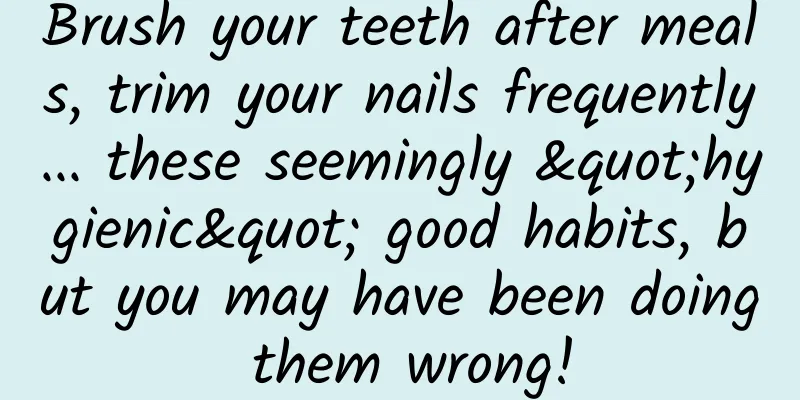Brush your teeth after meals, trim your nails frequently... these seemingly "hygienic" good habits, but you may have been doing them wrong!

|
We have been instilled with the awareness of "cleanliness and hygiene" since childhood. Coupled with the epidemic, the level of attention to hygiene has reached a "new high". But did you know that some of the "hygienic habits" we have always adhered to in life are actually unnecessary and even dangerous to our health! 01 If your nails are cut too short, beware of paronychia We are often reminded by our elders to "cut our nails short. Leaving them too long will easily harbor dirt and breed bacteria." Therefore, some people cut their nails very short, even "close to the flesh." However, if the nails are cut too short or too deep, the skin folds on both sides will lose the restraint of the nails and will grow toward the middle. When the nail grows back, it is like a hard thorn piercing the soft tissue in the nail groove, causing ingrown nails, pain, fluid, suppuration and other symptoms; If bacteria enter through the wound and cause infection, it may lead to paronychia. Copyright image, no permission to reprint 1. Three key points for correct nail cutting ① Soak in warm water before cutting Before cutting your nails, you can soak them in warm water for about a minute to allow the nails to absorb water and soften. This will not only save effort and make them easier to cut, but also prevent the nails from flying around. If you find it troublesome, after taking a shower is also a good time to cut your nails. ② Leave 1 mm when cutting When trimming, start from the middle and then move to the sides. This way it is easier to control the length, and leave a small white edge of about 1 mm exposed at the tip of the nail. ③Smooth sharp edges After trimming, trim the edges slightly, and then use a nail file to smooth the sharp edges. Generally speaking, it is recommended that adults trim their nails once a week. Copyright image, no permission to reprint 02 Cover your mouth when you sneeze? It may hurt others and yourself According to research data, when we sneeze, the nose and mouth expel air at the same time, and the saliva and nasal secretions will form 1000-40000 droplets that are sprayed out at high speed in the air, which can carry bacteria or viruses to a distance of about 2 meters. And there are about 300,000 microorganisms in a normal person’s sneeze! If you cover your mouth and nose with your hands, you can indeed prevent droplets from spreading into the air, but there are also hidden dangers! When you cover your mouth with your hands when you sneeze, microorganisms will attach to your hands. If you touch other surfaces without washing your hands in time, you may spread the flu virus to others through contact, especially people with low immunity. When you sneeze, strong pressure is created in your upper airways. If you cover your mouth and nose completely, the unrelieved pressure will "return" inward, impacting the Eustachian tube and even damaging the eardrum. In severe cases, it may cause perforation of the eardrum! Correct way: If you want to sneeze, don't hold it in. Cover your mouth lightly with a handkerchief or tissue. If you are in a hurry and have no time to prepare, cover your mouth with your elbow or sleeve. Because the elbows have less chance of touching other parts, it is less likely to cause the spread of bacteria and viruses. Copyright image, no permission to reprint 03 Pinch both nostrils to blow your nose? Be careful not to hurt your ears Colds, seasonal changes, and rhinitis are most likely to cause a runny nose. So how do you usually blow your nose? Should you press one nostril and blow hard at the other; or pinch both nostrils and blow hard at the same time? Let me tell you, if you block both nostrils and blow your air at the same time, it is very dangerous! When you pinch both sides of the nostrils and blow your nose hard, some of the snot cannot be blown out from the shrunken nostrils and will flow back into the sinuses or even into the middle ear cavity through the Eustachian tube, causing a buzzing sensation in the ears. The bacteria contained in the mucus may cause otitis media or aggravate sinusitis. Correct way: Close your mouth, press one nostril with your fingers, blow the mucus out of the other nostril, and then switch sides. Be careful not to use too much force. 04 Are you addicted to picking your ears? Beware of hearing loss When ears itch, many people will naturally use cotton swabs or ear picks to pick them out, which makes them feel refreshed both physically and mentally. And once you get used to it, you will want to pick your ears whenever you have free time. Everyone believes that earwax is the waste produced by the body's metabolism, and it must be cleaned thoroughly to keep the ear canal clean. In fact, proper earwax does have certain benefits - it can lubricate the ears and prevent dust from entering the ear canal. A study by the National Institutes of Health found that if there is no earwax at all, it is more likely to cause infection and induce external auditory canal eczema or external otitis. Frequent ear cleaning may cause damage to the skin of the external auditory canal. Once bacterial infection occurs, it may cause acute external otitis, with obvious symptoms such as external ear pulling pain, pain in the ear, and a feeling of ear obstruction. If an ear pick or cotton swab enters the ear canal without proper control of the depth, it may damage the eardrum. If the eardrum is punctured or perforated, there is a risk of hearing loss. Correct way: Generally speaking, earwax can be discharged by chewing, opening the mouth, etc., and there is no need to dig it out. You can try this when your ears are uncomfortable. ① First, gently pull and rub the auricle and earlobe with your hands. ② If it is really necessary to remove earwax, you should wash your hands first, soak a medical sterilized cotton swab in warm water and squeeze it dry, slightly insert it into and wipe the external auditory canal, and gently rotate it in one direction to remove the earwax. Copyright image, no permission to reprint 05 Brush your teeth immediately after a meal to protect your teeth? Easy to damage tooth enamel Brushing teeth is a good habit. For most people, brushing teeth twice a day, morning and evening, has become a habit. However, some people brush their teeth immediately after a meal, or even brush their teeth no matter what they eat. In fact, this is not good for dental health. Because there is a layer of enamel on the surface of the crown, especially after eating acidic foods or drinking fruit juice, the acidic substances can make the enamel crystals loose. If you brush your teeth immediately at this time, the enamel crystals will be easily brushed off. Over time, the tooth enamel will gradually decrease and become easily damaged. Therefore, it is advisable to rinse your mouth after a meal and brush your teeth half an hour later. 06 Can boiling bowls sterilize? When dining out, you may see a "pre-meal ritual" like this: tear open the tableware packaging, pour hot water, and start washing and rinsing... thinking that this can "disinfect and sterilize" and make use of it with greater peace of mind. But does this really work? 1. High temperature disinfection requires two conditions to be met at the same time Some experts said that for high-temperature disinfection to be effective, two conditions must be met at the same time - one is the temperature of action, and the other is the time of action, neither of which can be missing. For example, bacteria such as E. coli, Salmonella, and Vibrio cholerae that are often left on tableware will die only after being exposed to 100°C for 5 minutes or 80°C for 10 minutes. The hepatitis B virus can be inactivated at 100°C for at least 10 minutes; Some bacterial spores that are not afraid of "scalding" need to be boiled for a longer time, such as tetanus spores which require 60 minutes and botulinum spores which require 3 hours. Copyright image, no permission to reprint In general, the water temperature provided by restaurants is often low, and many people only scald their dishes for a dozen seconds at most, which cannot guarantee the killing of most pathogenic microorganisms. Its greatest effect may be to remove some dust. 2. It is also not advisable to wipe tableware with disinfectant wipes In addition to scalding with hot water, some people also use wet wipes to wipe and disinfect tableware. However, most of the cleaning and antibacterial wet wipes on the market can only be used for skin cleaning and cannot play the role of disinfecting tableware. Wet wipes that can achieve disinfection effects are also used to disinfect the skin or surfaces of objects. The chemical components in them are not ingestible, and using them to wipe dishes will increase safety risks. Therefore, when eating out, try to go to restaurants that meet hygiene standards, or you can bring your own set of tableware. Review|Li Nannan Director of Hunan Science Writers Association, Deputy Director of Research and Publicity Department of Hunan Science and Technology Association, Second-level Researcher, Chinese Science Writer (Medical Field) Source: I am a great doctor official account The cover image and the images in this article are from the copyright library Reproduction of image content is not authorized |
<<: If I have a cold or flu, will the nucleic acid and antigen tests be positive?
>>: Why do roosters crow in the morning?
Recommend
Volkswagen Group (China) debuts at the 6th CIIE: In China, for China, leading a new era of smart mobility
[Shanghai, November 5, 2023] Volkswagen Group (Ch...
APP promotion and operation planning, a new way of event operation!
Suppose a scenario where people are shopping offl...
Android bottom navigation bar implementation (Part 3) TextView+LinearLayout
Here is a brief record of implementing the Androi...
How amazing is the iPhone 7 Plus dual camera + "portrait" mode?
The dual-camera upgrade of iPhone 7 Plus is the bi...
After using Siri for so long, do you know these tricks?
Siri has been released since 2011 and is now six ...
Sony Bluetooth Speaker SRS-HG10 vs. BOSE Soundlink Mini II: Powerful low-frequency speakers are not afraid of the test
Comparing and evaluating speakers is a thankless ...
SiriOS may be released soon to help Apple's smart home ecosystem
Following iOS, MacOS, watchOS and iPadOS, Apple&#...
Magic from pixels! How does super-resolution technology make blurry pictures look brand new?
In today's digital age, video and images are ...
Mobile QQ chat history can finally be migrated! Mobile QQ new version experience
The new version of mobile QQ 8.1.8 is here. This ...
QQ will launch the online number cancellation function: it can be realized in QQ 7.9.9 and above
The QQ number deregistration function will be imp...
There are many types of disinfectants. Have you chosen the right one?
With the progress of science and technology, huma...
The great design debate: Will being as cumbersome as WeChat become a mess?
From buying train tickets to finding a massage se...
Zhou Xiaopeng's "36 Strategies for Happy Women in Love" helps you unlock the secrets of intimate relationships
Training course content: National senior psycholo...
Sailing east six times? This is Jianzhen's voyage eastward
Sailing east six times? This is Jianzhen's vo...
Can you get infected with influenza B after influenza A? Actually, there is no need for "after", and the person who infected you is still treating you...
Recently there is a topic called #Can influenza A...









